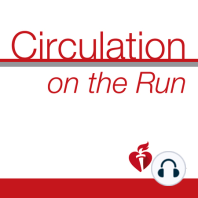16 min listen
Circulation January 16, 2018 Issue
ratings:
Length:
21 minutes
Released:
Jan 15, 2018
Format:
Podcast episode
Description
Dr. Carolyn Lam: Welcome to Circulation on the Run, your weekly podcast summary and backstage pass to the journal and its editors. I'm Dr. Carolyn Lam, Associate Editor from the National Heart Center and Duke National University of Singapore. This week's feature paper takes a deep dive into nitric oxide signaling, that extremely important pathway in cardiovascular health and disease. This time, taking a novel look at genetic predisposition, phenotypic consequences, and therapeutic implications. All that coming right up after these summaries. The first original paper describes the derivation and validation of a novel model to stratify the risk of death due to circulatory etiology in patients resuscitated from cardiac arrest without an ST elevation MI. First author, Dr. Bascom, corresponding author Dr. Setter from Maine Medical Center in Portland and their colleagues use the International Cardiac Arrest Registry to derive a novel model termed the CREST Model, which describes an incrementally high risk of circulatory etiology death with an increasing score. Now, CREST is a simple score with components of C for prior coronary artery disease. R for non-shockable rhythm. E for ejection fraction less than 30% on admission. S for shock at the time of admission. T for ischemic time more than 25 minutes. The authors showed that this CREST tool may allow for estimation of circulatory risk and improve triage of cardiac arrest survivors without STEMI at the point of care. The next study reports associations between usual sodium, potassium and blood pressure using gold standard 24-hour urinary data collected for the first time among a nationally representative sample of adults in the United States. First and corresponding author Dr. Jackson from Centers for Disease Control and Prevention used cross-sectional data from 766 participants aged 20 to 69 years with complete blood pressure and 24-hour urine collections in the 2014 national health and nutrition examination survey. They found that there was a strong direct relationship between higher sodium excretion and higher blood pressure and hypertension. In addition, there was an inverse relationship between potassium excretion and blood pressure and hypertension. When added to the evidence based from longitudinal and interventional studies, these results support clinicians dietary advise to lower sodium intake and increase consumption of potassium containing foods. The next two studies in this week's journal examine the utility of circulating biomarkers to aid in the diagnosis of acute aortic dissection. As a reminder, the AHA/ACC guidelines published in 2010, proposed using the aortic dissection detection risk score or ADD risk score as a primary screening tool based on scoring the presence of three categorical risks. Number one, high risk conditions such as Marfan Syndrome, a family history of aortic disease, known aortic valve disease, known thoracic aortic aneurysm or previous aortic manipulation. Number two, The pain features such as chest, back or abdominal pain described as being of abrupt onset severe intensity or ripping, tearing. Number three, the examination features such as evidence of profusion deficit, systolic blood pressure difference, spoken neurological deficit or aortic diastolic murmur and hypertension or shock. The presence of one or more markers within each of these categorical features is given an ADD score of one with a maximum cumulative score of three if all three categorical features are present. In the first of these t
Released:
Jan 15, 2018
Format:
Podcast episode
Titles in the series (100)
Circulation June 6, 2017 Issue: Circulation Weekly: Your Weekly Summary & Backstage Pass To The Journal by Circulation on the Run
